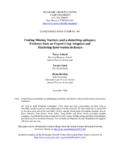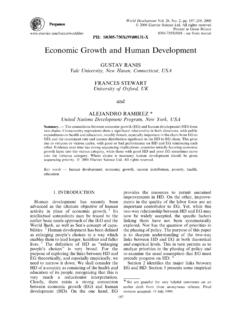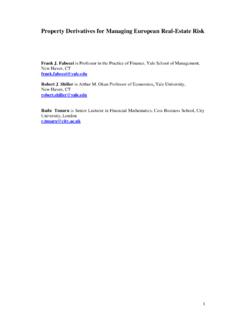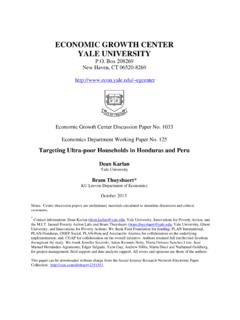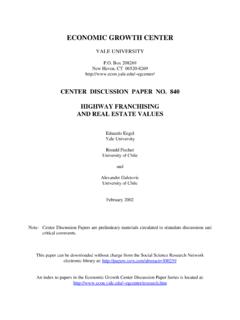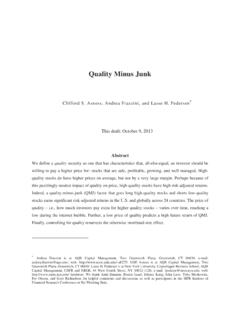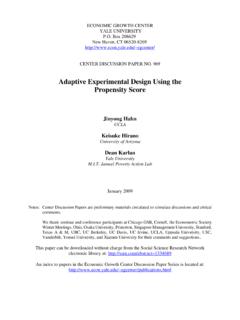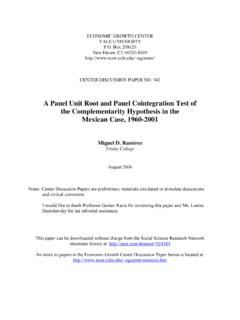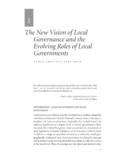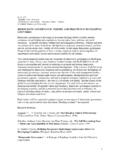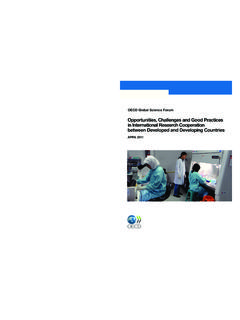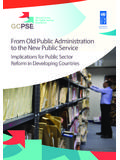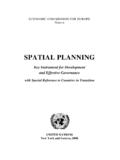Transcription of Rural Financial Markets in Developing Countries
1 ECONOMIC GROWTH CENTERYALE Box 208629 New Haven, CT 06520-8269 ~egcenter/CENTER DISCUSSION PAPER NO. 914 Rural Financial Markets in Developing CountriesJonathan ConningHunter College, City University of New YorkandChristopher UdryYale UniversityJune 2005 Notes: Center Discussion Papers are preliminary materials circulated to stimulate discussionsand critical for The Handbook of Agricultural Economics, Vol. 3, AgriculturalDevelopment: Farmers, Farm Production and Farm Markets , edited by Evenson, , , and T. P. Schultz. Last edited: June 20, paper can be downloaded without charge from the Social Science Research Networkelectronic library at: index to papers in the Economic Growth Center Discussion Paper Series is located at: ~ Financial Markets in Developing CountriesJonathan Conning and Christopher UdryThis review examines portions of the vast literature on Rural Financial Markets andhousehold behavior in the face of risk and uncertainty.
2 We place particular emphasis onstudying the important role of Financial intermediaries, competition and regulation in shaping thechanging structure and organization of Rural Markets , rather than on household strategies andbilateral contracting. Our goal is to provide a framework within which the evolution of financialintermediation in Rural economies can be codes:O16, Q14, O17, O12 Keywords: Rural Finance, Financial Intermediation, Agricultural Credit 1 Chapter 15 Rural Financial Markets IN Developing Countries JONATHAN CONNING Department of Economics, Hunter College, City University of New York, New York, NY CHRISTOPHER UDRY Department of Economics, Yale University, New Haven, CT Table of Contents 1 2 2 Salient Characteristics of Rural Financial Markets .
3 6 Fragmented or absent Markets ..6 Government 3 Models of Rural Financial Markets .. 20 The complete Markets benchmark ..22 Empirical tests of efficient risk sharing ..25 Consequences of imperfect Financial Markets ..26 Contracting under asymmetric information and imperfect Moral Multi-period and Repeated Contracts, Limited Commitment, and Limited Liability, Collateral and its Property rights and credit 4 Rural Financial 57 Crowding-in vs. Crowding-out of Financial Group Loans, Cooperatives, ROSCAs, and Mutuals ..69 Policies to promote Rural Financial intermediation.
4 73 5 Conclusion .. 75 Bibliography ..77 Prepared for The Handbook of Agricultural Economics, Vol. 3, Agricultural Development: Farmers, Farm Production and Farm Markets , edited by Evenson, , P. Pingali, and T. P. Schultz. Last edited: June 20, 2005. 21 Introduction The organization of Rural economic activity in general, and agricultural production in particular, is strongly conditioned by the fact that inputs are transformed into outputs with considerable time lags, and that production and sale outcomes can be highly uncertain because of the vagaries of nature or the swings of volatile commodity Markets .
5 In such environments, the ability of agricultural enterprises and Rural households to make long-term investments, take calculated risks, and create stable consumption streams will be shaped by the set of available Financial instruments and strategies to transform one pattern of variable and uncertain resource inflows and outflows into another. If the available set of Financial services is very limited, households may have to forego valuable investment and income-generating activities and suffer the consequences of volatile consumption. Financial transactions are implicit within, and often the reason behind, many contractual and organizational forms in the Rural economy.
6 Financial innovation therefore can have dramatic consequences on the ownership and governance structures of agricultural firms and community institutions. Financing options can affect decisions such as the physical placement and scale of agricultural operations, crop choices, and the decision to invest in risky but profitable new technologies or infrastructure. They may also affect choices about the size and composition of the Rural household, and decisions such as whether to migrate, how much to invest in education, or the use of child labor. The availability of financing can also be a force that shapes political dynamics within a community, for example by affecting agent s outside opportunities and bargaining power.
7 Making new Financial services and contract forms available can be viewed as a form of opening to trade. Agents in a financially isolated Rural economy have little choice but 3to transform one set of variable and uncertain cash flows into another using available production and storage technologies and local Financial instruments. Since risks in a local Rural economy are typically subject to common external shocks and the pool of savings may be limited, local Markets often cannot offer very good diversification opportunities and the cost of funds may be high. The introduction of new Financial instruments allows agents to face new relative price tradeoffs across time periods and state-contingent events.
8 The new trading opportunities this creates may then allow agents to specialize in higher value income activities while at the same time allowing households to purchase smoother consumption streams. Unfortunately, agents in the Rural sectors of most Developing Countries remain cut-off from many of the opportunities for investing, risk-taking and risk spreading that would be available through better Financial integration into larger national and global Financial Markets (de Soto 2000). An important research agenda is to understand the dynamics of Financial innovation. There are both winners and losers from the introduction of new Financial services and opportunities for trade.
9 Losers may include incumbent local Financial service providers who may stand to lose monopoly rents or market share in the face of increased outside competition (Rajan and Zingales 2003; Platteau 1997), or those who might fear for the collapse of local informal insurance mechanisms (Scott 1976). Just as common have been the calls by organized groups of borrowers or activists for political and economic authorities to intervene to regulate allegedly exploitative or harmful activities of informal moneylenders or landlords. Whether these fears were in reality justified or not, these constituencies, or those who would claim to speak for them, have often led political movements that have 4opposed Financial market liberalization or have lobbied to favor government interventions in Rural finance.
10 In many cases a history of heavy-handed political interventions has led Rural Financial Markets to become repressed and distorted (Gurley and Shaw 1960; Adams, Graham, and Von Pischke 1984; Gonzalez-Vega 1984; McKinnon 1973). Yet even where financially repressive policies have been lifted or never materialized, the entry of new Financial intermediaries to help local communities realize the gains to Financial trade has often proven difficult or been delayed because serious information asymmetries and enforcement problems lead to market failures that are difficult to repair. For all these reasons observers continue to disagree on the role of government in promoting or repressing efficiency-enhancing Financial intermediation.
